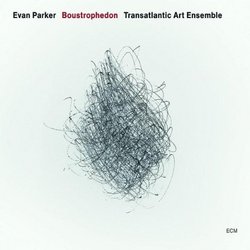Finally.
greg taylor | Portland, Oregon United States | 05/13/2008
(5 out of 5 stars)
"Some of us have been looking forward to this release for a year or two. This is a companion volume to ECM's Roscoe Mitchell release "Improvisations Nos. 1,2&3". Both that release and Boustrophedron were recorded in September, 2004 at concerts in Munich. They both feature the Transatlantic Art Ensemble which is made up of long-time associates of the two principles, Mitchell and Parker. The personel is as follows-
Evan Parker- soprano saxophone
Roscoe Mitchell- soprano and alto sax
Anders Svanoe- alto sax
John Rangecroft- clarinet
Neil Metcalfe- flute
Corey Wilkes- trumpet, fluegelhorn
Nils Bultmann- viola
Phillip Wachsmann- violin
Marcio Mattos- cello
Craig Taborn- piano
Jaribu Shahid, Barry Guy- double bass
Tani Tabbal, Paul Lytton- drums and percussion.
I want to offer some basic info about the structure of Parker's piece and then a few comments on the music. My remarks on the structure of the piece are based on Steve Lake's excellent liner notes.
Boutrophedon is from Greek and means "turning like an ox while ploughing".
This sort of left to right then right to left movement seems to have suggested to Parker a grouping of musical analogies including that of the improvisor emerging from the written score and then returning to it.
Structurally, the music has eight parts. The very brief Overture is followed by six 'Furrows' each of which is structured around a pair of musicians, one from each side of the Transatlantic Art Ensemble. The Finale is then centered around a sequence of individual cadenzas.
The first Furrow features flute and piano, the second viola and violin, the third cello and the alto sax of Svanoe, the fourth clarinet and trumpet, the fifth Furrow is for both bassists and the sixth Furrow features first Parker on soprano and then Mitchell tearing it up on alto.
After that last furrow, the Finale's cadenzas seem relatively calm until the final orchestral chords.
A couple of remarks. Apparently, Parker conducts throughout but Mitchell also conducts from the Furrow 4 on (if I understand the liner notes correctly). This was to add another level of unpredictability to the way the musicians contributed to the piece. I am not sure I can hear any difference but I would be interested to hear from others if they do.
Some of the musicians on this recording simply leave you no choice but to be awed. Taborn is outstanding both supporting soloists and as an individual voice. Wilkes on Furrow 4 is a delight. His feature is played largely muted (I think) and he is a master of the trumpeter's craft of tone manipulation. I need to see if I can find some CDs where he is the leader. Furrow 6 featuring Parker and Mitchell is the most typically jazzy part of the recording. They are both fierce but the way Mitchell charges in about ten seconds after Parker fades to silence is a superb moment crafted by both men.
My fellow reviewer, R. Hutchinson, thought in his review of the Mitchell piece that it could have done with more rehersal time for everyone in the band to get to know each other. I know exactly what he means. I felt the same thing about the recording featuring the Italian Instabile Orchestra recording with Cecil Taylor. But I do believe that there are moments aplenty on all three CDs to delight the listener. Parker, Mitchell and Taylor are rare birds- musical creators that work in a million different directions. Each man has over fifty years of creative effort and learning behind everything they do. Give this recording a listen, see what you get out of Parker's efforts. For myself, I have enjoyed it immensely.
"


 Track Listings (8) - Disc #1
Track Listings (8) - Disc #1